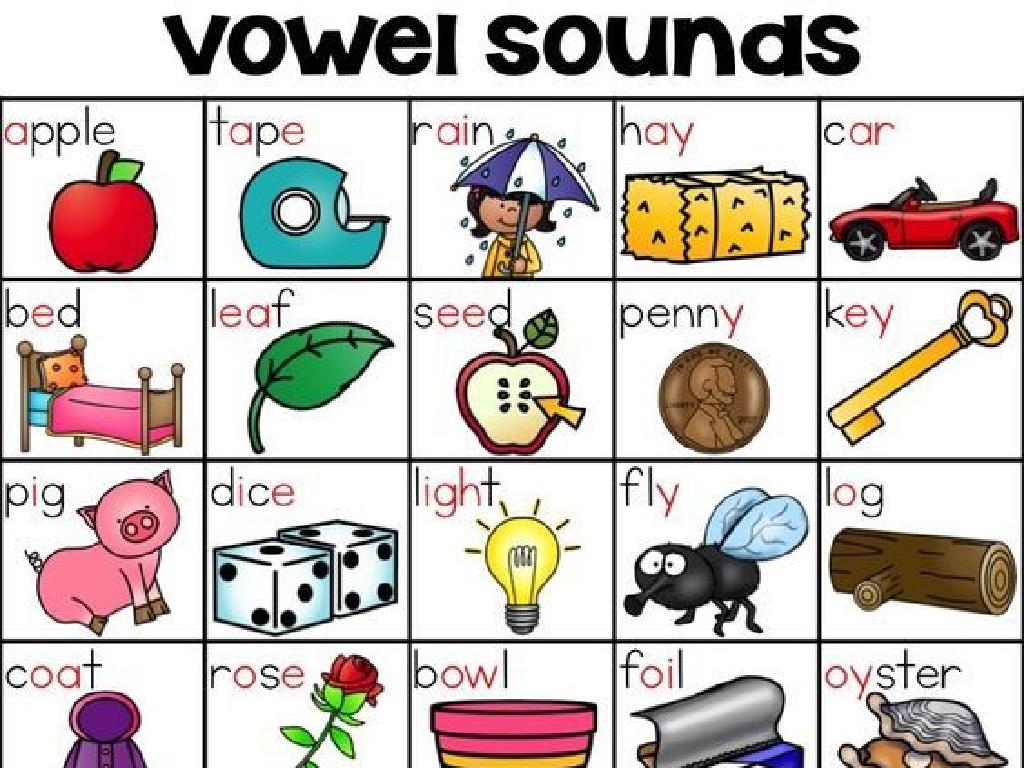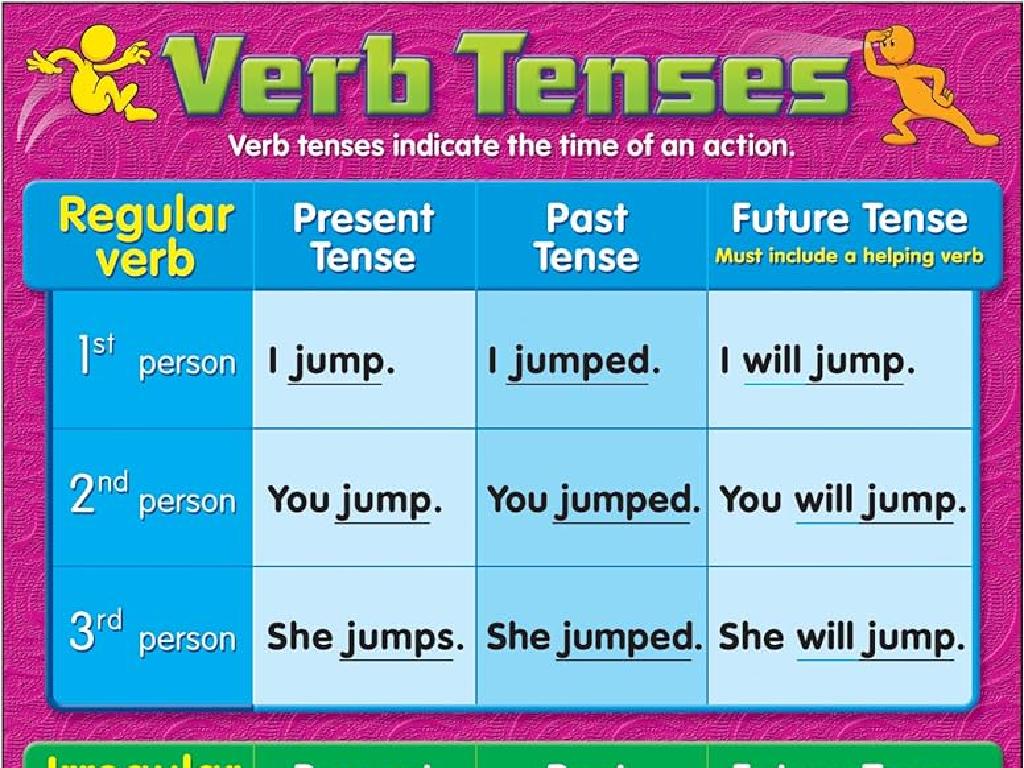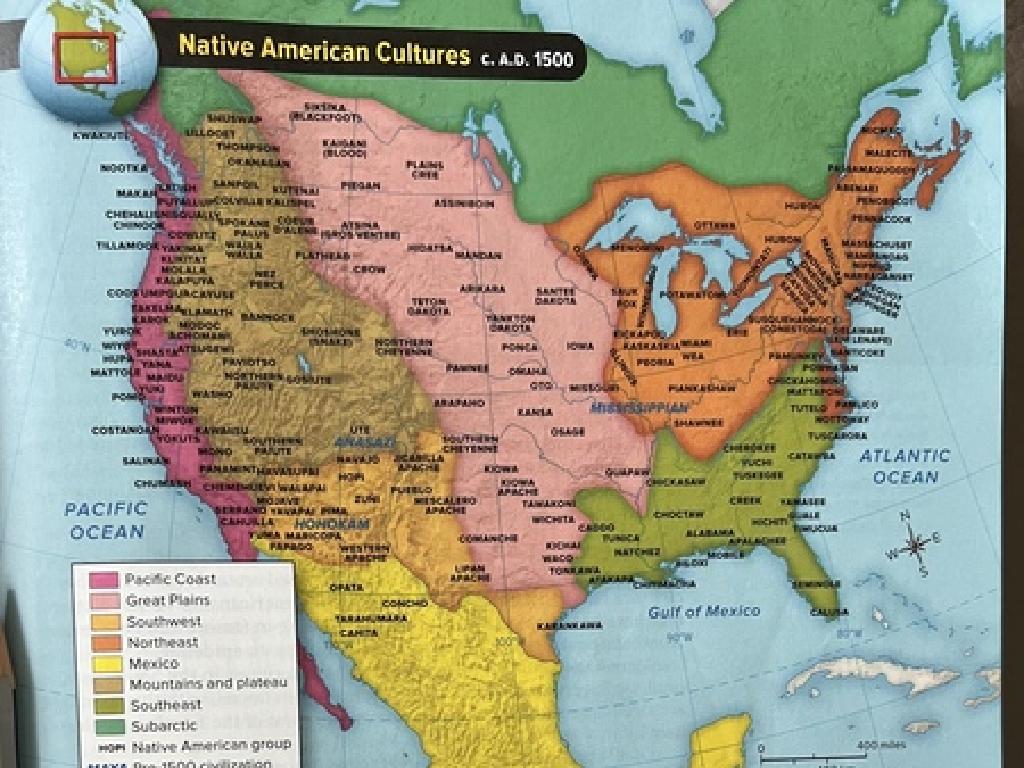Choose The Soft G Or Soft C Sentence That Matches The Picture
Subject: Language arts
Grade: Second grade
Topic: Soft G And C
Please LOG IN to download the presentation. Access is available to registered users only.
View More Content
Exploring Soft G and C Sounds
– Introduction to Soft G and C
– Soft G sounds like ‘j’, and soft C sounds like ‘s’.
– Examples of soft G and C words
– Words like ‘giraffe’ for soft G and ‘city’ for soft C.
– Importance of soft G and C in reading
– Recognizing these sounds helps us read new words correctly.
– Practice spelling with soft G and C
|
Begin the lesson by introducing the concept of soft G and C sounds. Engage the students by asking if they can think of any words that have these sounds. Explain that understanding how to identify and pronounce these sounds is crucial for their reading and spelling skills. Provide examples of words with soft G and C, and show pictures to help them remember. Encourage the students to listen for these sounds in words during reading exercises and to use them in their spelling. Plan a few simple activities where students can practice identifying and using soft G and C in words, such as matching games or fill-in-the-blank exercises.
Exploring Soft G Sounds
– Understanding Soft G
– Soft G is a G that sounds like ‘j’
– Soft G sounds like ‘j’
– Examples: ‘giraffe’, ‘giant’
– Occurs before ‘e’, ‘i’, ‘y’
– ‘ge’, ‘gi’, ‘gy’ make G soft
– Practice saying soft G words
– Let’s say ‘giraffe’, ‘gem’, ‘gym’ together
|
This slide introduces the concept of the soft G sound to second graders, which is an important part of understanding phonics in Language Arts. Start by explaining that the letter ‘G’ can make two sounds, and today we’re focusing on the soft G sound, which is similar to the sound of ‘j’. Provide examples like ‘giraffe’ and ‘giant’ and point out that this soft sound occurs when ‘G’ is followed by ‘e’, ‘i’, or ‘y’. Engage the class by saying some soft G words together, making it interactive. Encourage the students to listen carefully to the sound and try to repeat it. This will help them in reading and writing activities involving words with the soft G sound.
Exploring Soft C Sounds
– Understanding Soft C
– Soft C sounds like ‘s’
– Example: ‘circle’, ‘city’
– Soft C before ‘e’, ‘i’, ‘y’
– It’s common before the vowels ‘e’, ‘i’, ‘y’
– Practice saying soft C words
– Let’s say ‘cent’, ‘cinder’, ‘cygnet’ together
|
This slide introduces the concept of the soft C sound to second graders. Begin by explaining that the letter ‘C’ can make different sounds depending on the letters that follow it. Emphasize that the soft C sound is similar to the ‘s’ sound and is typically found before the letters ‘e’, ‘i’, or ‘y’. Engage the class by saying some soft C words together, like ‘cent’, ‘cinder’, and ‘cygnet’, and encourage the students to repeat after you. This will help them recognize and remember the sound pattern. Make sure to correct pronunciation as needed and provide positive reinforcement to build their confidence.
Matching Soft G and C with Pictures
– Observe the pictures displayed
– Decide if it’s a soft G or C word
– Is it a gentle ‘j’ sound or a soft ‘s’ like in ‘city’?
– Choose the matching sentence
– Sentences will be read aloud for each picture
– We’ll do it as a group activity
|
This slide is designed for a group activity to help second-grade students understand the concept of soft G and C sounds in words. Display pictures that represent words with either soft G (like ‘giraffe’) or soft C (like ‘cereal’). Encourage the students to look at each picture and think about the word it represents, focusing on the initial sound. Is it a soft G (as in ‘giraffe’) or a soft C (as in ‘cereal’)? Read sentences that contain these words, and as a class, decide which sentence correctly matches the picture based on the sound. This interactive approach will help students associate visual cues with phonetic sounds, reinforcing their understanding of soft G and C in a fun and engaging way.
Exploring Soft G and C Sounds
– Examples of soft G and C words
– Words like ‘giraffe’ and ‘cage’ show the soft G and C sounds.
– Notice the soft G and C in words
– The soft G sounds like ‘j’, and soft C sounds like ‘s’ before e, i, or y.
– Read examples aloud together
– Practice pronunciation as a group activity.
– Understanding through practice
|
This slide introduces students to the concept of soft G and C sounds in words. Start by explaining that the letter G can make a soft sound similar to ‘j’, and the letter C can make a soft sound like ‘s’ when followed by the letters e, i, or y. Provide examples such as ‘giraffe’ for soft G and ‘cage’ for soft C. Engage the class by reading these examples out loud together, which will help them recognize and pronounce these sounds correctly. Encourage students to listen carefully to the sounds and repeat them. This interactive approach will help solidify their understanding of how soft G and C are used in different words.
Practice Time: Soft G and C Sounds
– Look at the picture carefully
– Choose the right soft G or C sentence
– Remember the sounds before ‘e’, ‘i’, ‘y’
– Soft G sounds like ‘j’, and soft C sounds like ‘s’
– Share your answer with the class
|
This slide is an interactive activity for students to apply their knowledge of soft G and C sounds. Display a picture that can be associated with a word containing either a soft G or C. For example, a picture of a ‘giraffe’ for soft G, or ‘city’ for soft C. Students should use the context of the picture to determine the correct sentence that matches the picture. Remind them to pay attention to the sound that G or C makes before ‘e’, ‘i’, or ‘y’, which typically softens the consonant sound. After students make their choice, they can share their reasoning with the class. This will help reinforce their understanding of the concept and provide an opportunity for peer learning. Prepare several examples so each student has a chance to participate.
Class Activity: Soft G and C Scavenger Hunt
– Explore the classroom for a scavenger hunt
– Find items with soft G or C sounds
– Look for items like ‘giraffe’ or ‘cereal’
– Pair up and list your findings
– Cooperation is key, work together!
– Share your list with the class
– Discuss why you think they’re soft G or C
|
This activity is designed to help students recognize and differentiate between the soft G and C sounds in a fun and interactive way. Before starting, explain what soft G (as in ‘giraffe’) and soft C (as in ‘cereal’) sounds are. Demonstrate with examples and ensure students understand the task. Have the students walk around the classroom in pairs, searching for items or pictures that represent words with soft G or C sounds. They should write these words down on a list. After the scavenger hunt, regroup and have each pair share their findings with the class. Discuss why these sounds are considered ‘soft’ and how they differ from the ‘hard’ G and C sounds. This will reinforce their phonics skills and improve their ability to decode words while reading.
Celebrating Our Soft G and C Hunt
– Congrats on the scavenger hunt!
– Reviewing soft G and C words
– Words like ‘giraffe’ and ‘ice’ use soft G and C sounds.
– Share a new word you learned
– Did you find any words during our hunt?
– Reflect on what we’ve learned
|
This slide is meant to wrap up the lesson on soft G and C sounds. Start by congratulating the students on completing the scavenger hunt activity. Then, transition into a review of the words they’ve learned, emphasizing the soft G and C sounds. Encourage participation by asking students to share a new word they discovered. This reinforces their learning and allows them to practice pronunciation. Finally, ask reflective questions to gauge their understanding and to encourage them to think about how they can apply this knowledge when reading and writing.






